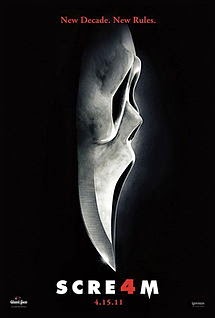Gothika (2003)
Directed by Mathieu Kassovitz
Horror/Thriller
Miranda Grey works at a women’s penitentiary, in the
mental institution department. We first see her interviewing Chloe (one of the
patients) about her rape that happened in her cell. Miranda doesn’t fully
believe her story and thinks that her drug doses should be lowered. Miranda has
to take a detour on her way home, as she goes over a bridge she swerves as she
thinks she has seen a young girl standing in the road. When she goes to help
the girl she suddenly bursts into flames. We hen see Miranda in a cell in the
women’s penitentiary where she once worked. She finds out that she murdered her
husband and becomes haunted by the same girl that she saw burst into flames.
Miranda finds out she was a victim of rape and kept in a rape den that her
husband created in an old barn. The ending of Gothika is open and leaves
room for a sequel.
The opening scene to Gothika impressed me the most
because it used dramatic, low key lighting; therefore this helped to create a
tense atmosphere. The lighting on Chloe’s face is half-light, half dark; this
gives the impression that she may look like a liar at the beginning, but she
may not towards the end of the film. I also liked the cinematography that was
used throughout the opening scene. Closes ups were used when Chloe was talking
so that the audience focuses solely on her, as well as expressionist angles so
that the viewer could understand Chloe and reflect on the tense, negative
atmosphere. Long takes were also used when Chloe was talking; this is another
technique used to engage the viewer with the character.
Another scene that impression me was the shower scene.
The use of cinematography, editing and mise-en-scene allowed the scene to
become tense and uneasy for the viewer to watch. The use of montage from slow
to quick editing allows the suspense to build. Also, the use of close ups and
fast paced editing allows the audience to feel a sense of panic. The low-key
lighting and the parallel, non-diegetic music all contribute towards the sense
of panic reflected into the audience; the music for this scene starts off with
a violin combined with low bass notes, it then goes deadly silent before
seeing the girl, then synthesized
keyboard notes are used to drag out and increase the suspense. The costumes, or
should I say lack of, contribute towards the patients feeling exposed and
violated, also it connotes their lack of freedom and trust.
Gothika has helped me to understand the horror
genre through its use of; character representations, mise-en-scene, sound,
editing, cinematography, narrative and ideologies.
V.Propp and T.Todorov defined the classical Hollywood
narrative’s structure. They broke it down into five phrases; ‘diegsis set out
equilibrium’; ‘equilibrium disrupted’; ‘quest to establish new stability’;
‘quest achieved’; ‘happy ending’; ‘new equilibrium’. Gothika follows
this theory for the majority of the film; the ending is not happy, but there is
a new equilibrium. The ending is an open ending; it shows Miranda walking down
the street, after meeting with Chloe, and a boy appears in the middle of the
road as a fire truck speeds past.
There are also stereotypes within Gothika. The psycho killer, Sheriff Ryan, is represented by a middle aged man who has an absent father and grew an over-dependent relationship with his mother. The male hero, Pete Graham, is very masculine, has facial hair, and is good looking. The female survivor/final girl, Miranda Grey, has dark hair, doesn’t wear much make-up and is a tom boy. The only character that does not follow the typical character stereotypes is the female victim, Chloe, who has black hair and is not killed. Stereotypes are used in the film Gothika to enable the audience to fully understand each character, as well as giving the audience hints as to what will happen with certain characters throughout the rest of the film.
Thomas Schatz’s “Genre Theory” can be applied to Gothika. Gothika has a hybrid genre; it is called as a horror and a thriller, therefore the audience can expect; gore, phallic weapons and a stereotypical antagonist from the genre horror; from the thriller genre the audience can expect tense atmosphere’s, sudden plot twists and unexpected attacks.
The use of close ups, high angles, low angles, shaky
camera movements and montages contributes largely towards the moods and
atmospheres felt throughout the film.
The aspects of the film that I want to include un my own
trailer are expressionist angles and shot distances, such as close ups, long
shots and high and low angles. I would also like to include montage, because
this increases tension. Also low-key lighting contributes towards the
atmosphere of the film therefore that would be an important element within the
making of my horror trailer. I would avoid using scenes would pro-long or
confuse the audience; for example, the dream sequences within Gothika
can be considered as quite confusing.
The best aspect of the film was exploring the inside of the mental institution during the scene where the guards were chasing Miranda. I could re-create this by using shaky camera angles to influence a sense of panic, also by using montages – slow to quick paced editing. I would also use point of view shots, close ups, and long shots to show action from different perspectives.
























